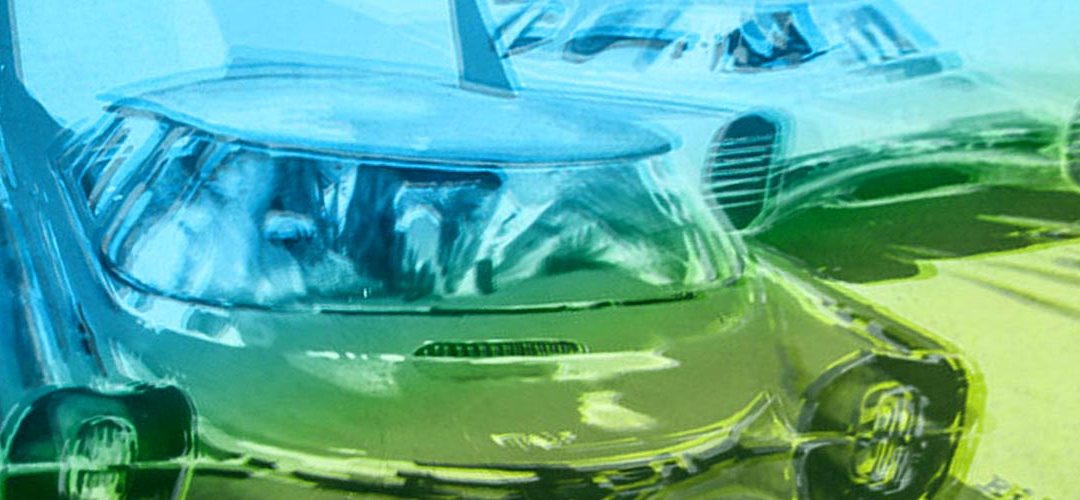Progress nowadays has taken the turbo. A thorough technology assessment is rarely possible — and time is rarely taken for it. With the example of self-steering cars, we can observe how we are fascinated or disturbed by technology, but in the end are overwhelmed.
2020. Self-driving cars have been around for well over 100 years. When horse-drawn carts were replaced by self-driving cars, some people were horrified: These cars simply drove straight into a wall — something that would never have happened with horses. If such a vehicle simply heads willlessly to where it is being steered, then good night, Mister! … — But in the end they did prevail, these wondrous “automobiles”.
Self-driving cars, one hears at the moment in Germany, are still things of the future. You need 5G for them and that will take time. The ethics committee is still in session. Things are not yet compatible. The big car companies still have to develop a bit and would like to pay out some dividends from their old technology.
Things happen
Actually, technically mature solutions already seem to exist. And when has progress ever waited for meaningful standards or ethics committees? When has one ever thoroughly clarified in the first place the exploitation rights to the data? We should do it, but it doesn’t seem to work that way. Things happen. Suddenly Google, Tesla, Uber or some yet unknown Chinese company says: Voilà, this is our self-steering car.
But do we really want to take a seat in there? As cyclists, do we want to encounter such a vehicle? Do we still want to let our children go outside when driverless delivery vans are curling around the house?
Every severe accident involving a self-steering car is a horror scenario for citizens, for potential users — and certainly for the manufacturer. Someone falls asleep on the motorway in his Tesla – a viral hit. And Uber, of course, had a huge problem when one of their self-steering cars killed a cyclist. The safety driver (let’s be honest) wasn’t alert and couldn’t react fast enough.
Do statistics help us?
Traffic fatalities caused by self-steering cars are hard to tolerate. Because the error of a system seems less forgivable to us than the error of a human being. “Human failure”? – Tragic, but to err is human and unavoidable in the end, like a natural catastrophe. For we can put ourselves in the shoes of people and their mistakes, while a complex machine appears to us as an uncanny black box.
As far as the assessment of risks is concerned, we humans are highly irrational. 9/11 is present to all of us because the terrorist attacks with almost 3,000 people killed were planned specifically to create strong images. While the opioid crisis in the USA has a death toll well over a hundred times as high – and yes, we may have heard of that too. The same applies to bicycle accidents with right-turning trucks (horrible, 13 deaths in Germany in 2017) or multiple drug resistant germs in hospitals (with 7,500 to 15,000 deaths in Germany per year).
We have a paradoxically rising alarm curve within us, which increases our fear when a danger is particularly spectacular or memorable: illness – accident – natural disaster – murder – terror. And somewhere, rather in the spectacular area sorted are the dangers of artificial intelligence and self-steering cars. “Operation robot runs amok!” – What a tabloid headline would that be? And who would then still trustfully lie down on a robot operating table, even if the statistics would speak for it?
… But then you get to thinking
About half of those surveyed in an international study conducted in 2017 stated that they would also have robots operate on them if they were considered reliable. This acceptance will increase with higher reliability, minized invasiveness or lower costs. Even with nursing robots, while the spontaneous reaction at first may be like ”nursing … what!?“, one gets to thinking: What if it enables me to continue living at my own home, if it ensures care around the clock, if it becomes clearly cheaper for me…?
So we weigh risks against benefits. The risk side is more based on gut feelings, while the advantage side is based on quite real temptations or at least promises.
So let’s ask ourselves: How safe must self-steering cars be before they are accepted into road traffic? 100 percent? Four times as safe as humans? What error rate should we tolerate? How fast are these cars allowed to drive in our cities – 30, 50, 100 km/h? Does the formula “maximum speed / road fatalities = X” turn out differently if the driving style has been programmed? Do we really have to solve ethical dilemmas beforehand, with decisions about groups of pensioners driven to death versus playing children? Or do we say at some point: “We’re not gonna do that anymore. We let that happen, as it happens, because the advantages are more important to us”?
.
A prognosis
I suppose that if self-steering cars are five to ten times safer in mixed traffic than human-controlled cars, and if accidents have disappeared from the news’ headlines, then there will be no stopping for computer-controlled individual traffic.
And then things will get even more interesting. Because our cities are adapted to the selfish, distracted and confused motorists of today. To people who ignore traffic signs and can only overcome intersections with traffic light control. When these things will change, our cities will be shaped differently. And maybe not for worse.
What would it be like if medium-sized streets could be passed safely without traffic lights or zebra crossings? Some people will even mob the cars by forcing them into abrupt maneuvers. Business people will go a few extra rounds so as not to interrupt the video conference, and lovers will cuddle while doing so. Shared robotaxis could reduce traffic volume, if we were only willing to use them. But more likely we will see empty cars in traffic jams, on their way to pick up childrem from school. Cars could hardly need to accelerate or brake because their algorithm looks far ahead. And perhaps they could also master the trick of crossing intersections like the cyclists in Groningen: with all traffic lights on green.
And how about us? We will feel like we’re on a plane: a little at the mercy, but in the end relaxed. It’s gonna be allright.
Did you know? Groningen was the first city in the Netherlands to implement simultaneous green lights for bikes.
At 29 different intersections, cyclists travel in all four directions at once; turning what might look like total chaos into a safer, more efficient way to get around. pic.twitter.com/XQV25zYMNg
— Dutch Cycling Embassy (@Cycling_Embassy) August 21, 2019
//

